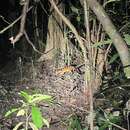pms
nòm ant ël fil


Die Bänder- und Otterzivetten (Hemigalinae) sind eine Unterfamilie der Schleichkatzen (Viverridae) und umfassen vier Arten:
Die Vertreter dieser Gruppe leben in Wäldern in Südostasien, wie alle Schleichkatzen sind sie vorwiegend nachtaktive Einzelgänger. Während die semiaquatische Otterzivette einen otterähnlichen Körperbau mit einem eher breiten Kopf und kurzem Schwanz hat, sind die anderen drei Vertretern auffallend schlanke, langgestreckte Tiere mit spitzer Schnauze.
Diese Tiere leben vorwiegend auf dem Boden und sind in stärkerem Ausmaß als andere Schleichkatzen Fleischfresser, wobei Würmer und Insekten zu ihrer bevorzugten Nahrung zählen.
Alle vier Arten sind relativ unbekannte, wenig erforschte Tiere, die zudem durch Waldrodungen in ihrem Bestand bedroht sind.
Die Bänder- und Otterzivetten (Hemigalinae) sind eine Unterfamilie der Schleichkatzen (Viverridae) und umfassen vier Arten:
Bänderroller (Hemigalus derbyanus) Fleckenroller (Chrotogale owstoni) Schlichtroller (Diplogale hosei) Otterzivette (Cynogale bennettii)Die Vertreter dieser Gruppe leben in Wäldern in Südostasien, wie alle Schleichkatzen sind sie vorwiegend nachtaktive Einzelgänger. Während die semiaquatische Otterzivette einen otterähnlichen Körperbau mit einem eher breiten Kopf und kurzem Schwanz hat, sind die anderen drei Vertretern auffallend schlanke, langgestreckte Tiere mit spitzer Schnauze.
Diese Tiere leben vorwiegend auf dem Boden und sind in stärkerem Ausmaß als andere Schleichkatzen Fleischfresser, wobei Würmer und Insekten zu ihrer bevorzugten Nahrung zählen.
Alle vier Arten sind relativ unbekannte, wenig erforschte Tiere, die zudem durch Waldrodungen in ihrem Bestand bedroht sind.
The Hemigalinae are a subfamily of the viverrids denominated and first described by John Edward Gray in 1864.[1] Hemigalinae species are native to Southeast Asia from southern China through Indochina, Malay Peninsula to Sumatra, Borneo and Sulawesi.[2]
The tails of Hemigalinae species are ringed. The toes and the middle of the lower part of the tarsus are bald. The frenum, upper part, and sides of the lower part are hairy. The orbit is imperfect.[1]
Hemigalinae resemble the Viverrinae in having the scent glands present in both sexes and wholly perineal, but differing by their simpler structure, consisting in the male of a shallower, smaller pouch, with less tumid lips, situated midway between the scrotum and the penis, but not extending to either. In the female, the scent glands consist of a pair of swellings, each with a slit-like orifice, situated one on each side of the vulva and a little behind it and on a common eminence, the perineal area behind this eminence being naked. The prepuce is long and pendulous. The feet are nearly intermediate in structure between those of the digitigrade Viverrinae and the semiplantigrade Paradoxurinae, but more like the latter, both the carpal and metatarsal pads being well developed, double, and joining the plantar pad below, and as wide as it is at the point of contact. But the feet, with the pads, are considerably narrower, the carpals and metatarsals converging and meeting above so that a much larger area of the under surface is hairy. The area between the four main digits and the plantar pad is covered with short hair, and the pads of the third and fourth digits of the hind foot are separated as in the Viverrinae, not confluent as in the Paradoxurinae. The retractile claws are not protected by skin-lobes.[3]
The Hemigalinae subfamily comprises the following five monospecific genera:[2]
The Hemigalinae are a subfamily of the viverrids denominated and first described by John Edward Gray in 1864. Hemigalinae species are native to Southeast Asia from southern China through Indochina, Malay Peninsula to Sumatra, Borneo and Sulawesi.
Los hemigalinos (Hemigalinae) son una subfamilia de mamíferos carnívoros de la familia Viverridae. Contiene cuatro géneros de civetas propias del Sureste Asiático.
Se han descrito los siguientes géneros:[1]
Los hemigalinos (Hemigalinae) son una subfamilia de mamíferos carnívoros de la familia Viverridae. Contiene cuatro géneros de civetas propias del Sureste Asiático.
Les Hémigalinés (Hemigalinae) sont une sous-famille de mammifères carnivores de la famille des viverridés.
Cette sous-famille comprend quatre genres monospécifiques:
Elle a été créée par John Edward Gray (1800-1875) en 1865.
Les Hémigalinés (Hemigalinae) sont une sous-famille de mammifères carnivores de la famille des viverridés.
Hemigalinae é uma subfamília de viverridae descrita por John Edward Gray em 1864.[1] Compreende 4 gêneros monoespecíficos:[2]
Hemigalinae é uma subfamília de viverridae descrita por John Edward Gray em 1864. Compreende 4 gêneros monoespecíficos:
Hemigalus Chrotogale Cynogale Diplogale
줄무늬사향고양이아과(Hemigalinae)는 사향고양이과에 속하는 아과 분류군의 하나로 1864년 존 에드워드 그레이가 처음 기술했다.[1] 각각 단일종을 가진 4개 속으로 이루어져 있다.[2]